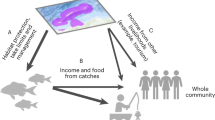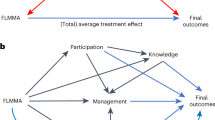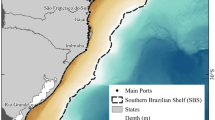Abstract
Marine protected areas are advocated as a key strategy for simultaneously protecting marine biodiversity and supporting coastal livelihoods, but their implementation can be challenging for numerous reasons, including perceived negative effects on human well-being. We synthesized research from 118 peer-reviewed articles that analyse outcomes related to marine protected areas on people, and found that half of documented well-being outcomes were positive and about one-third were negative. No-take, well-enforced and old marine protected areas had positive human well-being outcomes, which aligns with most findings from ecological studies. Marine protected areas with single zones had more positive effects on human well-being than areas with multiple zones. Most studies focused on economic and governance aspects of well-being, leaving social, health and cultural domains understudied. Well-being outcomes arose from direct effects of marine protected area governance processes or management actions and from indirect effects mediated by changes in the ecosystem. Our findings illustrate that both human well-being and biodiversity conservation can be improved through marine protected areas, yet negative impacts commonly co-occur with benefits.
This is a preview of subscription content, access via your institution
Access options
Access Nature and 54 other Nature Portfolio journals
Get Nature+, our best-value online-access subscription
$29.99 / 30 days
cancel any time
Subscribe to this journal
Receive 12 digital issues and online access to articles
$119.00 per year
only $9.92 per issue
Buy this article
- Purchase on Springer Link
- Instant access to full article PDF
Prices may be subject to local taxes which are calculated during checkout





Similar content being viewed by others
Data availability
The data that support the findings of this study are available in the Supplementary Information.
References
TARGET 11 - Technical Rationale extended (provided in document COP/10/INF/12/Rev.1) Convention on Biological Diversity https://www.cbd.int/sp/targets/rationale/target-11/ (2010).
Transforming Our World: The 2030 Agenda for Sustainable Development (United Nations, 2015); https://sustainabledevelopment.un.org/post2015/transformingourworld
Jones, K. R. et al. The location and protection status of Earth’s diminishing marine wilderness. Curr. Biol. 28, 2506–2512 (2018).
Halpern, B. S. et al. Spatial and temporal changes in cumulative human impacts on the world’s ocean. Nat. Commun. 6, 7615 (2015).
Edgar, G. J. et al. Global conservation outcomes depend on marine protected areas with five key features. Nature 506, 216–220 (2014).
Lester, S. E. et al. Biological effects within no-take marine reserves: a global synthesis. Mar. Ecol. Prog. Ser. 384, 33–46 (2009).
Mascia, M. B., Claus, C. & Naidoo, R. Impacts of marine protected areas on fishing communities. Conserv. Biol. 24, 1424–1429 (2010).
Chaigneau, T. & Brown, K. Challenging the win–win discourse on conservation and development: analyzing support for marine protected areas. Ecol. Soc. 21, 36 (2016).
Diedrich, A., Stoeckl, N., Gurney, G. G., Esparon, M. & Pollnac, R. Social capital as a key determinant of perceived benefits of community‐based marine protected areas. Conserv. Biol. 31, 311–321 (2017).
Gurney, G. G. et al. Participation in devolved commons management: multiscale socioeconomic factors related to individuals’ participation in community-based management of marine protected areas in Indonesia. Environ. Sci. Policy 61, 212–220 (2016).
Arias, A., Cinner, J. E., Jones, R. E. & Pressey, R. L. Levels and drivers of fishers’ compliance with marine protected areas. Ecol. Soc. 20, 19 (2015).
Guidetti, P., Bussotti, S., Pizzolante, F. & Ciccolella, A. Assessing the potential of an artisanal fishing co-management in the marine protected area of Torre Guaceto (southern Adriatic Sea, SE Italy). Fish. Res. 101, 180–187 (2010).
Gelcich, S., Godoy, N. & Castilla, J. C. Artisanal fishers’ perceptions regarding coastal co-management policies in Chile and their potentials to scale-up marine biodiversity conservation. Ocean Coast. Manag. 52, 424–432 (2009).
Jenkins, A., Horwitz, P. & Arabena, K. J. My island home: place-based integration of conservation and public health in Oceania. Environ. Conserv. 45, 125–136 (2018).
Pollnac, R. et al. Marine reserves as linked social-ecological systems. Proc. Natl Acad. Sci. USA 107, 18262–18265 (2010).
Sala, E. et al. Assessing real progress towards effective ocean protection. Mar. Policy 91, 11–13 (2018).
Jones, P. Equity, justice and power issues raised by no-take marine protected area proposals. Mar. Policy 33, 759–765 (2009).
Kaplan‐Hallam, M. & Bennett, N. J. Adaptive social impact management for conservation and environmental management. Conserv. Biol. 32, 304–314 (2018).
Bennett, N. J. et al. Local support for conservation is associated with perceptions of good governance, social impacts and ecological effectiveness. Conserv. Lett. https://doi.org/10.1111/conl.12640 (2019).
Gurney, G. G., Pressey, R. L., Cinner, J. E., Pollnac, R. & Campbell, S. J. Integrated conservation and development: evaluating a community-based marine protected area project for equality of socioeconomic impacts. Phil. Trans. R. Soc. Lond. B 370, 20140277 (2015).
Matulis, B. S. & Moyer, J. R. Beyond inclusive conservation: the value of pluralism, the need for agonism, and the case for social instrumentalism. Conserv. Lett. 10, 279–287 (2016).
Mouffe, C. Deliberative democracy or agonistic pluralism? Soc. Res. 66, 745–758 (1999).
Hill, L. S., Johnson, J. A. & Adamowski, J. Meeting Aichi Target 11: Equity considerations in marine protected areas design. Ocean Coast. Manag. 134, 112–119 (2016).
Hicks, C. C. et al. Engage key social concepts for sustainability. Science 352, 38–40 (2016).
Breslow, S. J. et al. Conceptualizing and operationalizing human wellbeing for ecosystem assessment and management. Environ. Sci. Policy 66, 250–259 (2016).
McKinnon, M. C. et al. What are the effects of nature conservation on human well-being? A systematic map of empirical evidence from developing countries. Environ. Evid. 5, 8 (2016).
Charnley, S. et al. Evaluating the best available social science for natural resource management decision-making. Environ. Sci. Policy 73, 80–88 (2017).
Pascal, N. et al. Evidence of economic benefits for public investment in MPAs. Ecosyst. Serv. 30, 3–13 (2018).
Álvarez-Romero, J. G. et al. Research advances and gaps in marine planning: towards a global database in systematic conservation planning. Biol. Conserv. 227, 369–382 (2018).
Fox, H. E. et al. How are our MPAs doing? Challenges in assessing global patterns in marine protected area performance. Coast. Manag. 42, 207–226 (2014).
Fox, H. E. et al. Reexamining the science of marine protected areas: linking knowledge to action. Conserv. Lett. 5, 1–10 (2012).
Twichell, J., Pollnac, R. & Christie, P. Lessons from Philippines MPA Management: social ecological interactions, participation, and MPA performance. Environ. Manag. 61, 916–927 (2018).
Christie, P., White, A. & Deguit, E. Starting point or solution? Community-based marine protected areas in the Philippines. J. Environ. Manag. 66, 441–454 (2002).
Gelcich, S. et al. Alternative strategies for scaling up marine coastal biodiversity conservation in Chile. Marit. Stud. 14, 5 (2015).
Jupiter, S. D., Cohen, P. J., Weeks, R., Tawake, A. & Govan, H. Locally-managed marine areas: multiple objectives and diverse strategies. Pac. Conserv. Biol. 20, 165–179 (2014).
Halpern, B. S. & Warner, R. R. Marine reserves have rapid and lasting effects. Ecol. Lett. 5, 361–366 (2002).
Suuronen, P., Jounela, P. & Tschernij, V. Fishermen responses on marine protected areas in the Baltic cod fishery. Mar. Policy 34, 237–243 (2010).
Hattam, C. E., Mangi, S. C., Gall, S. C. & Rodwell, L. D. Social impacts of a temperate fisheries closure: understanding stakeholders’ views. Mar. Policy 45, 269–278 (2014).
Yang, Y.-C., Wang, H.-Z. & Chang, S.-K. Social dimensions in the success of a marine protected area: a case in a Taiwan fishing community. Coast. Manag. 41, 161 (2013).
Oracion, E. G., Miller, M. L. & Christie, P. Marine protected areas for whom? Fisheries, tourism, and solidarity in a Philippine community. Ocean Coast. Manag. 48, 393–410 (2005).
Gurney, G. G. et al. Poverty and protected areas: an evaluation of a marine integrated conservation and development project in Indonesia. Glob. Environ. Change 26, 98–107 (2014).
Cudney-Bueno, R. et al. Governance and effects of marine reserves in the Gulf of California, Mexico. Ocean Coast. Manag. 52, 207–218 (2009).
Buchy, M. & Race, D. The twists and turns of community participation in natural resource management in Australia: What is missing? J. Environ. Plan. Manag. 44, 293–308 (2001).
Källström, H. N. & Ljung, M. Social sustainability and collaborative learning. Ambio 34, 376–382 (2005).
Bruckmeier, K. Interdisciplinary conflict analysis and conflict mitigation in local resource management. Ambio 34, 65–73 (2005).
Le Tissier, M., Hills, J., McGregor, J. & Ireland, M. A training framework for understanding conflict in the coastal zone. Coast. Manag. 32, 77–88 (2004).
McNeill, A., Clifton, J. & Harvey, E. S. Attitudes to a marine protected area are associated with perceived social impacts. Mar. Policy 94, 106–118 (2018).
Bennett, N. J. Using perceptions as evidence to improve conservation and environmental management. Conserv. Biol. 30, 582–592 (2016).
Elwell, T. L., Gelcich, S., Gaines, S. D. & López-Carr, D. Using people’s perceptions of ecosystem services to guide modeling and management efforts. Sci. Total Environ. 637, 1014–1025 (2018).
Underwood, A. On beyond BACI: sampling designs that might reliably detect environmental disturbances. Ecol. Appl. 4, 3–15 (1994).
Pomeroy, R. S, Parks, J. E. & Watson, L. M. How is Your MPA doing? A Guidebook of Natural and Social Indicators for Evaluating Marine Protected Area Management Effectiveness. (IUCN: 2004).
Mascia, M. B. & Claus, C. A. A property rights approach to understanding human displacement from protected areas: the case of marine protected areas. Conserv. Biol. 23, 16–23 (2009).
Leisher, C., Samberg, L. H., Van Buekering, P. & Sanjayan, M. Focal areas for measuring the human well-being impacts of a conservation initiative. Sustainability 5, 997–1010 (2013).
Biedenweg, K., Stiles, K. & Wellman, K. A holistic framework for identifying human wellbeing indicators for marine policy. Mar. Policy 64, 31–37 (2016).
Adger, W. N. et al. Governance for sustainability: towards a ‘thick’ analysis of environmental decision-making. Environ. Plan. A 35, 1095–1110 (2003).
R Core Team R: A Language and Environment for Statistical Computing (R Foundation for Statistical Computing, 2018); http://www.R-project.org/
Warnes, G. R. et al. Various R Programming Tools for Plotting Data (2016); https://cran.r-project.org/web/packages/gplots/gplots.pdf
Protected Planet: The World Database on Protected Areas (UNEP-WCMC and IUCN, accessed October 2018); https://www.protectedplanet.net/
Maritime Boundaries Geodatabase: Maritime Boundaries and Exclusive Economic Zones (200NM) version10 (Flanders Marine Institute, 2018); https://doi.org/10.14284/312
World Countries (ESRI, 2016); https://www.arcgis.com/home/item.html?id=ac80670eb213440ea5899bbf92a04998
Acknowledgements
N.C.B. hosted a workshop of co-authors that was made possible by her Lansdowne Scholar Award from the University of Victoria, and the OceanCanada SSHRC Partnership. N.J.B. recognizes the OceanCanada Partnership; G.G.G. recognizes funding from the Australian Research Council and C.K.W. recognizes support from an NSERC Canada Graduate Scholarship. S.G. recognizes CONICYT BASAL FB-0002. The British Columbia government provided S.B.’s time; the views presented are those of the author, not of BC Parks.
Author information
Authors and Affiliations
Contributions
N.C.B. conceived of the idea, reviewed the literature, led study design, collated quantitative data, carried out analyses and drafted the paper. All authors contributed ideas and to study design, reviewed papers for qualitative information and edited the paper. C.K.W. and T.C.T. reviewed the quantitative data.
Corresponding author
Ethics declarations
Competing interests
The authors declare no competing interests.
Additional information
Publisher’s note: Springer Nature remains neutral with regard to jurisdictional claims in published maps and institutional affiliations.
Supplementary information
Supplementary Information
Supplementary Tables 1–6, Supplementary Fig. 1, Supplementary references 1–118
Supplementary Data Set
Data used in author analysis
Rights and permissions
About this article
Cite this article
Ban, N.C., Gurney, G.G., Marshall, N.A. et al. Well-being outcomes of marine protected areas. Nat Sustain 2, 524–532 (2019). https://doi.org/10.1038/s41893-019-0306-2
Received:
Accepted:
Published:
Issue Date:
DOI: https://doi.org/10.1038/s41893-019-0306-2
This article is cited by
-
Marine protected areas promote stability of reef fish communities under climate warming
Nature Communications (2024)
-
Marine ecosystem-based management: challenges remain, yet solutions exist, and progress is occurring
npj Ocean Sustainability (2024)
-
What are the impacts of activities undertaken in UNESCO biosphere reserves on socio-economic wellbeing in Southeast Asia? A systematic review
Environmental Evidence (2023)
-
Hybridizing research and decision-making as a path toward sustainability in marine spaces
npj Ocean Sustainability (2023)
-
Co-benefits of marine protected areas for nature and people
Nature Sustainability (2023)



